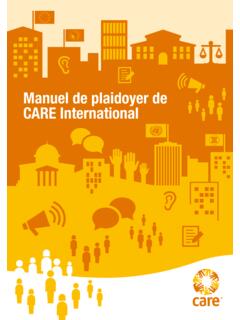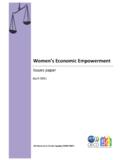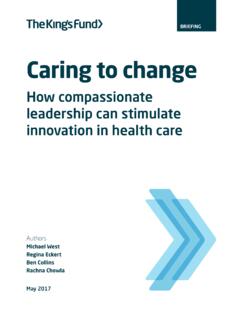Transcription of THE CARE INTERNATIONAL ADVOCACY HANDBOOK
1 THE CARE INTERNATIONAL ADVOCACY HANDBOOKP ublished by CARE INTERNATIONAL May 2014 CARE INTERNATIONAL 2014 CARE INTERNATIONAL SecretariatChemin de Balexert 7-91219 ChatelaineGenevaSwitzerlandTel: +41 22 795 10 manual has been written with the help of Alice Allan CIUK, Martha Chouchena Rojas CI Secretariat, Margie Lauter CARE USA, Sarah Lynch CARE USA , Celine Mias CARE Brussels, Aisha Rahamatali CI Secretariat and Sofia Sprechman CI Secretariat. It has been reviewed by CARE s ADVOCACY and Media Committee and colleagues with expertise on gender and governance. It has been piloted in a variety of trainings with colleagues from 13 different country illustration: Dilhan Attanayake. Design: Richard Reeve. Printing: Introduction 1 What is ADVOCACY ? 1 Why advocate at CARE? 2 How ADVOCACY fits into CARE s theory of 4 social change 2. The ADVOCACY planning and 6 implementation cycle STEP 1 The problem 8 STEP 2 The external context 10 STEP 3 Defining the goal 12 STEP 4 Who can make the change?
2 16 STEP 5 Policy asks and core messages 24 STEP 6 Resources 26 STEP 7 Action plan and 29 implementation STEP 8 Monitoring and evaluation 353. Managing risk, ensuring 39 consistency Appendix: Online resources 43 Case Studies1. SWASH+ Sustaining and Scaling School Water, 6 Sanitation and Hygiene Plus Community Impact STEP 12. SWASH+ How the Problem Tree helped 93. Working with the women s rights movement in 9 Latin America STEP 24. SWASH+ Why SWASH+ maintained an 11 external focus 5. INTERNATIONAL politics and women s rights 11 STEP 36. Food aid reform 127. Shaping a G8 agenda 158. Linking savings groups to banks 159. SWASH+ goals 15 STEP 410. National to Global ADVOCACY in 18 Afghanistan 11. Working with secondary targets 1812. ADVOCACY in an insecure environment 18 taking a back seat 13. Taking the lead: the Child Nutrition 18 Initiative in Peru 14. SWASH+ Taking the insider track 1815. Shaping the next set of UN 20 Development Goals 16. Shaping Climate Change Adaptation Funds 2117.
3 Influencing the EU on emergencies 2218. The INTERNATIONAL Conference of the 23 Great Lakes Region ContentsTools1. Problem Tree 92. PESTLE analysis 103. Objectives Tree 134. Testing the rationale: Theories of Change 145. Helping to prioritise criteria analysis 156. Stakeholder mapping 177. Communicating for influence 248. Planning effective research for ADVOCACY 30 and campaigning 9. CI ADVOCACY M&E framework 3610. Revised ADVOCACY logic model 37 IllustrationsThe Three Key Elements Of Effective ADVOCACY 3 CARE s Inclusive Governance Model 5 The ADVOCACY Planning And Implementation Cycle 7 Tool 1: The Problem Tree 8 Tool 2: Pestle Analysis 10 Tool 3: The Objectives Tree 13 Tool 6: Stakeholder Mapping 17 How CARE Can Link Its Local-National-Global 19 ADVOCACY Tool 7: Communicating For Influence 24 Tool 8: Planning Effective Research For 30 ADVOCACY And Campaigning Tool 9: CI ADVOCACY Monitoring And 39 Evaluation Framework Tool 10: CARE USA Learning Tours: Revisited 37 ADVOCACY Logic Model Lynn Woolsey s Champion-ness over time 38 TablesTool 5: Criteria analysis 14 Killer facts 25 Approval processes 41 Risk mitigation 42 STEP 519.
4 CARE counts the cost of violence 25 against women in Bangladesh 20. Establishing new banking principles with 26 the private sector 21. SWASH+ How policy objectives led to 26 concrete change STEP 622. GLAI: funding for a regional initiative 2823. Seeking national government funds 28 in Bangladesh STEP 724. Women, peace and security strategy: 29 outcomes and activities 25. SRMH ADVOCACY strategy: outcomes 29 and activities 26. Syria ADVOCACY strategy 2927. Generating evidence from CARE Bangladesh s 31 SHOUHARDO programme 28. Using social accountability to build evidence 31 in Peru 29. Using data to change how rape is reported 32 in Uganda 30. Securing a climate change loss and 32 damage mechanism 31. High profile visits to CARE programmes 3332. CARE USA s Action Networks (CAN) 3333. Supporting other CAREs to build their 33 supporter network 34. Supporting southern voices for 34 climate change 35. Social media: campaigning to end 35 child marriage STEP 836. SWASH+ How SWASH+ used flexible 38 learning to aid M&E 37.
5 The learning tour scorecard 3838. Peru scorecards 381 CARE s primary asset in the fight against poverty is the knowledge, ideas, and experience gained through its implementation of coherent programs that draw on rights-based perspectives and gender analysis; the strong connections within and across CARE and poor and marginalised communities, social movements, governments, civil society, academia, the private sector, foundations, and individuals (both activists and donors), and its strong capacity for local-to-global ADVOCACY . CARE is integral to delivering CARE s vision. This manual is a toolkit of approaches, techniques and additional resources to help CARE staff think about how to integrate ADVOCACY into their work. It has been updated from its original 2001 version to take into account various developments in CARE, such as the programme approach and the focus on women and girls. It also recognises that CARE now works in a range of contexts, from fragile to middle income states, and with new actors.
6 The manual is structured around an eight-step ADVOCACY planning cycle and could be used to plan an initiative from start to finish or dipped into at any point during the process. It is key to remember that ADVOCACY is not a linear process but a more complex one where plans have to be adapted when contexts is ADVOCACY ?Often national and INTERNATIONAL policies to protect poor and marginalised communities are absent, ineffective or not implemented. CARE s definition of ADVOCACY recognises this and is as follows: ADVOCACY is the deliberate process of influencing those who make decisions about developing, changing and implementing policies [in CARE s case: to reduce poverty and achieve social justice]. CARE s ADVOCACY might be focused on issues in the public ( public service provision) or private ( the rights of domestic workers in the home, or garment workers in factories) sphere. CARE and many other organisations have long argued for private issues, such as female genital cutting, to become issues of public concern.
7 Often the people we are working with interact mostly in the informal sector or space. Part of our role as CARE is to facilitate or build bridges between people living in poverty and formal institutions ( local authorities and national government, parliaments, donors). The role of being a convener is, in fact, a central one for promoting dialogue resulting in pro-poor policies. At CARE, ADVOCACY is the means by which we choose to influence decision-makers, or the tactics, while policy is the content, or the ask, the what we want to change . One cannot be done without the other. ADVOCACY and policy at CARE are targeted at power-holders above the household at CARE: key termsWhat does influencing look like? ADVOCACY is about influencing those who make policy decisions. Decision-makers are generally those who have the ability to legislate, negotiate or set budgets relating to formal public policies ( district and municipal officers, national civil servants, parliamentarians, ministers in national governments and INTERNATIONAL institutions such as the United Nations (UN)).
8 Decision-makers are not necessarily always the power holders. Their decisions can often be heavily influenced by those who hold formal and informal power in society including business, the media, religious leaders, and social movements amongst others. There are many ways to influence decision-makers and power holders, including outsider tactics of confrontation and public mobilisation, to insider tactics of lobbying behind the scenes. ADVOCACY can be done alone or in coalition. There is no one size fits all approach; each context will require different does deliberate process mean? ADVOCACY is a deliberate process, involving intentional actions. Therefore, before implementing ADVOCACY strategies, it is important to be clear who the strategy is trying to influence and which policy it is attempting to does developing, changing and implementing policies mean?Often policies are outdated or non-existent, or deliberately block what we want to achieve, so legislative 1. IntroductionThe CARE INTERNATIONAL ADVOCACY HANDBOOK Introduction2changes are required.
9 In other cases policies are perfect on paper but are not being implemented. In this instance ADVOCACY might focus more on trying to get policies enacted. For example, in many countries there are now various provisions for gender equality under the law; however this does not necessarily mean that access to land titles for women is becoming easier. In this case, an intervention might mean partnering with a legal NGO to force implementation of the legislation through the courts. It could also involve partnering with a national radio station to raise awareness of non-implementation and encourage national ADVOCACY is notExtension workEncouraging households to change their agricultural or health practices is an important programming strategy used in many CARE programmes. However, extension work is designed to influence individual decisions made at the household level, not the behaviour or decisions of policy-makers that affect many and communicationAdvocacy intends to change or implement a policy issue.
10 It will always need to be supported by tactical communications ( strong key messages and relationships with influential journalists that power holders take notice of). ADVOCACY messages can have the beneficial effect of raising public awareness of CARE s work. However, general communications, case studies and photographs of projects, do not count as the government about CAREB uilding good relationships with decision-makers is an important way to lay the foundation for ADVOCACY and build credibility. However, ADVOCACY is not just about informing the government about CARE s programmes. In ADVOCACY , information-sharing is used as a deliberate strategy to influence specific decisions of primary purpose of ADVOCACY is not to increase CARE s funds. Some ADVOCACY may involve asking policy-makers to allocate more resources for relief and development priorities, and sometimes this may benefit CARE. Additionally strong insider ADVOCACY can position CARE to shape donor priorities. More often, however, it involves trying to influence a governmental agenda, corporate behaviour, a specific public policy, or the implementation of a advocate at CARE?











